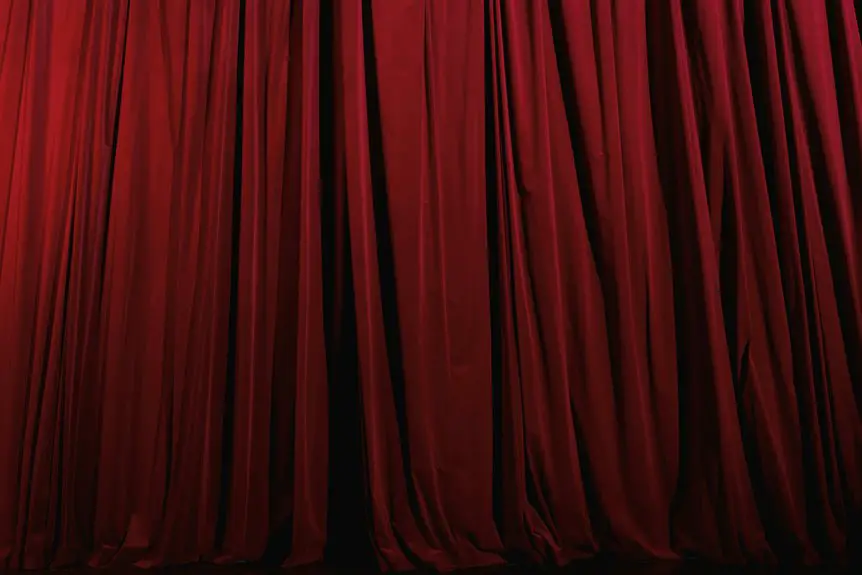You can enhance your home decor with crepe fabric by choosing from silk, wool, cotton, or polyester types, each offering unique texture and durability. Crepe adds rich visual appeal and resists wrinkles, making it perfect for elegant curtains and cozy pillow covers. It also diffuses light softly and fits various styles, from modern to traditional. If you want to learn how to select, sew, and care for crepe fabric to transform your space beautifully, there’s more to explore.
Table of Contents
Key Takeaways
- Crepe fabric’s textured surface adds visual interest and softness, enhancing curtains, pillow covers, and other home decor items.
- Choose crepe types like silk for elegance, wool for warmth, polyester for durability, or cotton for breathability in decor applications.
- Lightweight crepe suits sheer curtains, medium weight balances privacy and light filtering, while heavyweight provides warmth and light blocking.
- Pair crepe with smooth or structured textiles, using complementary colors and layering to create cozy, dynamic interior designs.
- Maintain crepe by washing gently in cold water, avoiding wringing, spot cleaning stains promptly, and ironing on low heat with a cloth.
What Is Crepe Fabric?
Crepe fabric is a textured material known for its crinkled or pebbled surface, which gives it a distinctive look and feel.
Crepe fabric features a unique crinkled texture that adds a distinctive look and tactile appeal.
When you touch crepe, you’ll notice its slightly rough texture combined with a soft drape. It’s made from various fibers like silk, wool, polyester, or cotton, each lending unique qualities.
The fabric’s texture results from a special weaving or twisting technique during production, creating those characteristic tiny wrinkles. You’ll find crepe lightweight yet durable, making it versatile for different uses.
Its natural elasticity means it resists wrinkles better than many other fabrics. Understanding what crepe fabric is helps you appreciate why it works so well in home decor, blending style with practicality effortlessly.
Types of Crepe Fabric Suitable for Home Decor
When choosing fabric for your home decor, you’ll find several types of crepe that stand out for their texture and durability.
Each variety brings a unique feel and appearance, making it easier for you to match your aesthetic needs.
- Silk Crepe: Luxurious and smooth, perfect for elegant curtains and pillow covers.
- Wool Crepe: Offers warmth and structure, ideal for heavier drapes or upholstery.
- Polyester Crepe: Durable and easy to maintain, great for everyday use in various decor items.
- Cotton Crepe: Breathable and soft, excellent for casual cushions and lightweight curtains.
Benefits of Using Crepe Fabric in Interior Design
You’ll love how crepe fabric adds rich texture and visual appeal to your space while standing up to daily wear with ease.
It’s also low-maintenance, so you won’t spend extra time fussing over it.
Plus, its versatility lets you use it in many design styles, making it a smart choice for any room.
Texture and Visual Appeal
Although some fabrics may fall flat in a room, crepe brings a unique texture that instantly elevates your space. When you choose crepe for your curtains or pillow covers, you add a subtle yet striking dimension that catches the eye without overwhelming the decor.
Its slightly crinkled surface offers a tactile quality that invites touch and adds warmth to any setting.
You’ll appreciate how crepe fabric:
- Diffuses light softly, enhancing natural illumination
- Adds depth through its intricate weave and texture
- Complements both modern and traditional design styles
- Creates visual interest without busy patterns or prints
Durability and Maintenance
Since crepe fabric combines resilience with ease of care, it makes an excellent choice for home decor that stands up to everyday use. You’ll find it durable enough for high-traffic areas, yet simple to maintain without special treatments. Whether for curtains or pillow covers, crepe resists wrinkles and retains its shape well. Cleaning is straightforward, often requiring just gentle washing or spot cleaning.
Here’s a quick look at its durability and maintenance:
| Feature | Benefit | Tip |
|---|---|---|
| Durability | Long-lasting fabric | Ideal for frequent use |
| Wrinkle Resistance | Keeps appearance neat | Minimal ironing needed |
| Cleaning | Easy care, gentle washing | Use mild detergent |
| Shape Retention | Maintains structure over time | Avoid harsh drying |
You’ll appreciate how crepe keeps your decor fresh and hassle-free.
Versatility in Design
How can crepe fabric elevate your interior design? Its unique texture and flexibility let you experiment without limits.
Whether you want subtle elegance or bold accents, crepe adapts seamlessly.
You’ll appreciate these versatile benefits:
- Texture variety: From smooth to heavily textured, crepe adds depth to any piece.
- Color richness: It holds dyes well, offering vibrant or muted tones to match your palette.
- Shape retention: Crepe drapes beautifully, maintaining crisp folds or soft flows.
- Multi-use: Ideal for curtains, pillow covers, upholstery, and even table runners.
Choosing the Right Crepe Fabric for Curtains
When picking crepe fabric for your curtains, consider the weight and opacity to control light and privacy effectively.
You’ll also want to explore color and pattern options that complement your room’s style.
Choosing the right combination guarantees your curtains look great and function well.
Fabric Weight and Opacity
Choosing the right crepe fabric for your curtains means considering both weight and opacity carefully. These factors influence how much light filters through and how the curtains drape.
Lighter crepe fabrics offer a delicate, airy feel but provide less privacy. Heavier crepes block more light and offer better insulation, perfect for bedrooms or living rooms. Opacity varies widely, so think about your room’s purpose and desired ambiance.
Keep these points in mind when selecting crepe fabric:
- Lightweight crepe: soft, translucent, ideal for sheer curtains
- Medium weight: balances light filtering with privacy
- Heavyweight crepe: blocks light effectively, adds warmth
- Opacity affects room brightness and privacy levels
Choosing wisely enhances both function and style in your home decor.
Color and Pattern Options
Beyond weight and opacity, the color and pattern of your crepe fabric play a big role in setting the mood of your space. When choosing curtains, think about the atmosphere you want to create.
Light, neutral tones like beige or soft gray bring calm and versatility, while bold colors like deep blue or emerald add drama and richness. Patterns can inject personality—florals soften a room, geometric prints add modern flair, and subtle textures enhance depth without overwhelming.
Remember, darker colors block more light, so balance your choice with how much natural light you want. Also, consider the existing decor to make certain your curtains complement rather than clash.
Designing Elegant Crepe Curtains: Tips and Tricks
Crafting elegant crepe curtains starts with understanding the fabric’s unique texture and flow. You’ll want to choose crepe with a medium weight to guarantee it hangs beautifully without being too stiff or too flimsy.
Next, consider the lining; a light lining can enhance privacy while allowing natural light to gently filter through. When sewing, use fine needles and sharp scissors to prevent fraying.
To elevate your design, focus on these key tips:
- Opt for simple, clean hems to showcase crepe’s natural drape
- Use subtle pleats or gathers for a refined silhouette
- Select coordinating hardware that complements crepe’s matte finish
- Test curtain length carefully to avoid dragging or awkward bunching
With these tricks, your crepe curtains will add timeless elegance to any room.
Creating Comfortable and Stylish Pillow Covers With Crepe
Pillow covers made from crepe fabric bring a perfect blend of comfort and style to your living space.
Crepe’s unique texture adds a subtle sophistication that instantly elevates any room. When you choose crepe, you get a soft, breathable material that feels great against your skin, making your pillows inviting and cozy.
Crepe’s soft, breathable texture adds subtle sophistication and cozy comfort to any room instantly.
Plus, crepe’s natural wrinkle resistance keeps your covers looking fresh with minimal effort. You can easily sew or purchase crepe pillow covers in various colors and patterns to match your decor.
Don’t forget to select a durable crepe blend if your pillows see heavy use. By incorporating crepe pillow covers, you’ll effortlessly enhance both the aesthetic and comfort of your sofas or beds.
Combining Crepe Fabric With Other Textiles in Your Space
Using crepe fabric for pillow covers shows how its texture and softness can elevate your home decor.
When you combine crepe with other textiles, you create a layered, inviting look that adds depth to any room.
Pair crepe’s subtle crinkle with smooth silks or polished linens to balance tactile interest. Mixing crepe with coarser fabrics like burlap or tweed introduces a rustic charm that enriches your space without overwhelming it.
To seamlessly blend crepe with other textiles, consider these tips:
- Match fabric weights for a cohesive feel
- Use crepe as a soft contrast against structured materials
- Layer textiles in complementary neutral tones
- Incorporate metallic accents to highlight crepe’s texture
This approach enhances your home’s style while keeping it cozy and dynamic.
Color and Pattern Options for Crepe Home Decor
You can choose from vibrant solid colors to make a bold statement with crepe fabric in your home.
Floral and geometric patterns add personality and style to any room.
Plus, customizable color palettes let you tailor your decor exactly to your taste.
Vibrant Solid Colors
Although crepe fabric is often celebrated for its texture, its vibrant solid colors truly make a room come alive. When you choose crepe for curtains or pillow covers, you’re not just adding texture—you’re injecting energy.
Solid colors in crepe hold their depth beautifully, enhancing your decor without overwhelming it. You can easily mix and match these hues to create a cohesive look or a bold statement.
Consider these options when picking your crepe color:
- Deep navy for a sophisticated, calming vibe
- Bright coral to add a cheerful pop
- Emerald green for a rich, natural feel
- Soft lavender to bring subtle elegance
With vibrant solids, your home decor stays fresh and visually striking.
Floral and Geometric Patterns
Floral and geometric patterns bring a fresh twist to crepe fabric, adding character and charm to your home decor.
When you choose floral designs, you introduce nature’s beauty indoors, creating a soothing, inviting atmosphere. These patterns can range from delicate blossoms to bold, oversized prints, giving you flexibility to match your style.
Geometric patterns, on the other hand, offer a modern, structured look that complements minimalist or contemporary spaces. Think sharp lines, repeating shapes, or abstract motifs that add visual interest without overwhelming your room.
Both patterns work beautifully on curtains and pillow covers, transforming simple crepe fabric into statement pieces.
Customizable Color Palettes
A vibrant color palette can transform crepe fabric into a striking element of your home decor. When choosing colors for crepe curtains, pillow covers, or table runners, you have the freedom to customize hues that perfectly match your space.
Crepe’s unique texture enhances both bold and subtle shades, making your selections pop or blend seamlessly.
Consider these options to personalize your crepe fabric:
- Rich jewel tones like emerald, sapphire, and ruby for a luxurious vibe
- Soft pastels such as blush pink, mint green, or powder blue for a calming effect
- Neutral shades including beige, taupe, and gray for versatile, timeless decor
- Bold contrasts like black and white or navy and gold for dramatic impact
With these choices, you can craft a look that’s uniquely yours.
Sewing and Handling Crepe Fabric for Home Projects
Working with crepe fabric requires a gentle touch and some specific techniques to make certain your home decor projects turn out beautifully.
When cutting crepe, use sharp scissors or a rotary cutter to avoid fraying edges. Pin sparingly and opt for fine pins to prevent fabric damage. Since crepe can stretch, handle it carefully to keep seams straight.
When sewing, use a smaller stitch length and a fine needle, like a size 70/10, to maintain fabric integrity. Press seams gently with a low-heat iron and a pressing cloth to avoid shine or distortion.
If your crepe is particularly delicate, consider using a walking foot to feed the fabric evenly.
These steps will help you create crisp, elegant curtains or pillow covers that showcase crepe’s unique texture.
Maintaining and Cleaning Crepe Fabric Items
Since crepe fabric has a delicate texture, you’ll want to take extra care when cleaning and maintaining your home decor items.
Crepe fabric’s delicate texture demands gentle care to keep your home decor looking its best.
To keep curtains, pillow covers, and other pieces looking fresh, follow these essential tips. Always check the care label before cleaning, as some crepe fabrics require dry cleaning. When washing at home, use cold water and a gentle detergent to avoid damage. Avoid wringing or twisting the fabric to preserve its texture.
Here are some key maintenance tips:
- Spot clean stains promptly with a mild solution
- Hand wash or use the delicate cycle on your machine
- Air dry flat or hang to dry away from direct sunlight
- Iron on low heat with a cloth barrier to prevent shine
Creative DIY Ideas Using Crepe Fabric at Home
Although crepe fabric is often admired for its texture and versatility, you mightn’t realize how easily it can transform your home with simple DIY projects.
Try making elegant fabric wall hangings by cutting crepe into geometric shapes and mounting them on canvases. You can also sew quick, stylish table runners or placemats that add a subtle pop of texture to your dining area.
For a cozy touch, create no-sew crepe fabric tassels or fringe to decorate lampshades or curtain tiebacks. If you enjoy crafting, try making fabric flowers or wreaths that brighten up any room.
These projects require minimal tools and can be customized with your favorite colors, letting you refresh your decor effortlessly and creatively using crepe fabric.
Where to Buy Quality Crepe Fabric for Home Decor
Wondering where to find quality crepe fabric for your home decor projects?
Start by exploring both online and local options to get the best material that suits your style and budget.
Explore online and local sources to find the perfect crepe fabric that fits your style and budget.
Here are some reliable places to evaluate:
- Specialty Fabric Stores: They offer a wide selection of crepe fabrics with varying textures and colors.
- Online Marketplaces: Websites like Etsy and Amazon provide diverse choices and customer reviews to help you decide.
- Wholesale Suppliers: Ideal if you’re planning large projects, offering fabric at lower prices.
- Craft and Hobby Shops: Perfect for smaller quantities and quick purchases.
Frequently Asked Questions
Can Crepe Fabric Be Used for Outdoor Home Decor?
You can use crepe fabric outdoors, but it’s not the best choice since it’s delicate and may not withstand weather well. You’ll want to treat it or opt for more durable, weather-resistant materials instead.
Is Crepe Fabric Hypoallergenic or Safe for Pets?
You’ll find crepe fabric generally hypoallergenic since it’s made from natural fibers, but it depends on the specific type. It’s usually safe for pets, but always check for any sensitivities or allergies your furry friends might have.
How Does Crepe Fabric Perform in Humid Climates?
Think of crepe fabric as a sponge dancing with humidity—it breathes well and resists moisture buildup. You’ll find it stays comfortable and wrinkle-resistant in humid climates, keeping your space fresh without feeling sticky or heavy.
What Is the Environmental Impact of Crepe Fabric Production?
You’ll find crepe fabric’s environmental impact varies—natural fibers like silk or cotton use more water and pesticides, while synthetic crepes involve petrochemicals. Choosing eco-friendly options or recycled fibers can help reduce your footprint considerably.
Can Crepe Fabric Be Used for Upholstery on Furniture?
Imagine wrapping your furniture in a cozy hug—crepe fabric can be used for upholstery, but it’s best for light-use pieces. You’ll want to avoid heavy wear since it’s delicate and might not hold up well over time.
- 7 Reasons Your Small Business Should Use Poly-Cotton for Merch - June 23, 2025
- How to Iron a Cotton Polyester Blend Without Damaging It - June 23, 2025
- Wrinkle-Resistant and Durable: Why Poly-Cotton Is an Easy-Care Fabric - June 23, 2025







